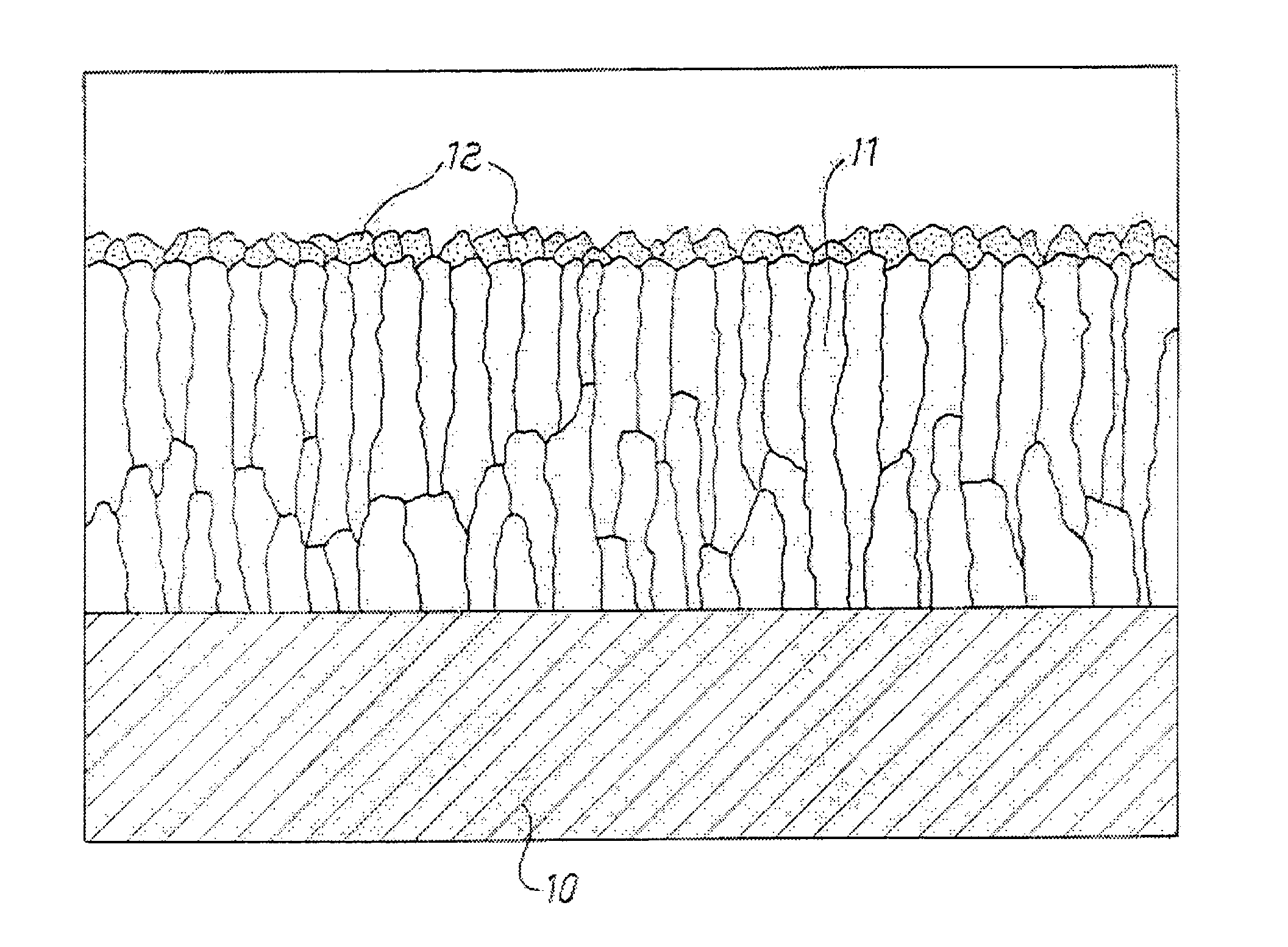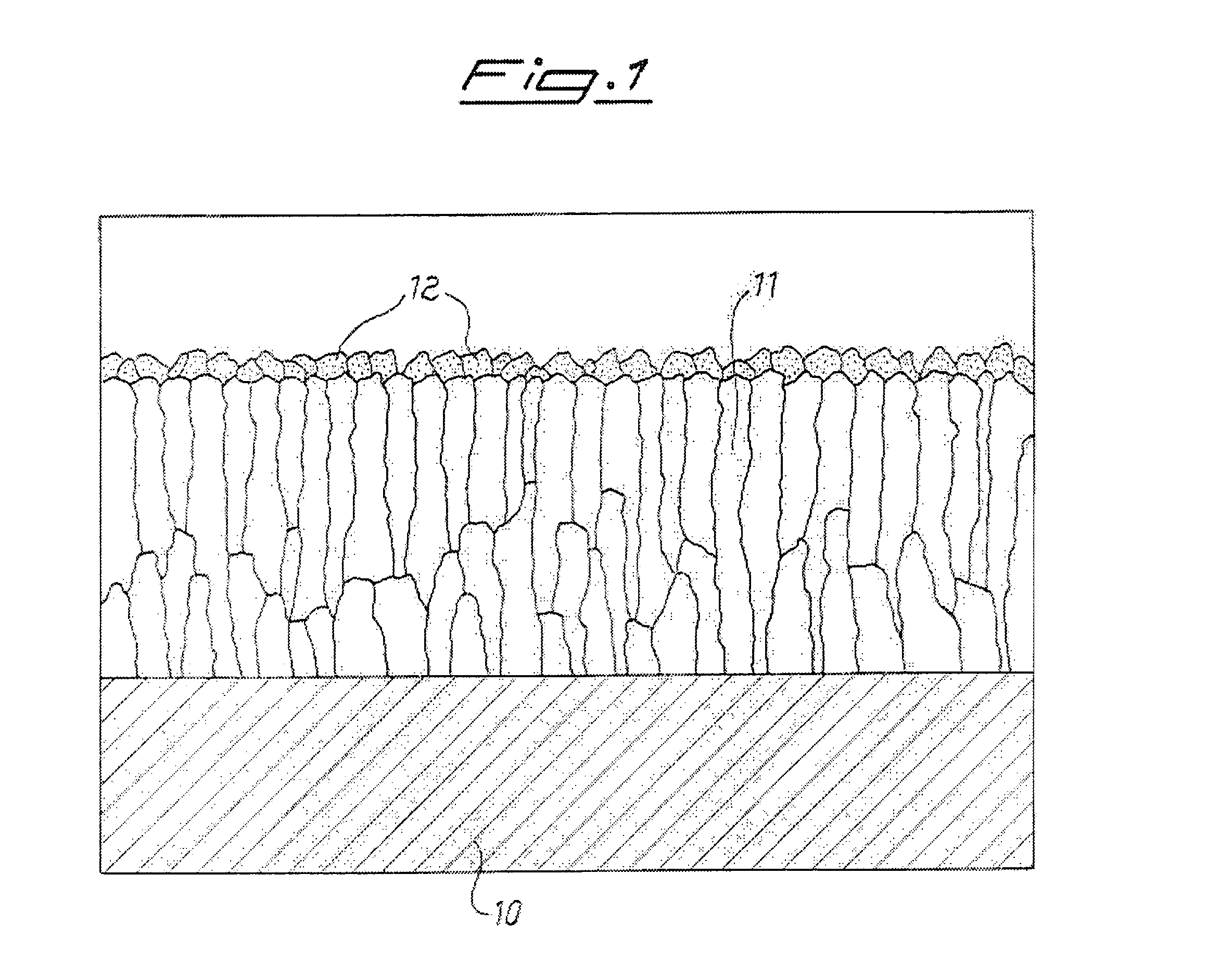Multilayer getter structures and methods for making same
a multi-layer, getter technology, applied in the direction of solid cathodes, gas-filled discharge tubes, x-ray tubes, etc., can solve the problems of low gas sorbing properties, short neg operating life, and inability to manufacture certain devices, etc., to achieve low activation and high surface area
- Summary
- Abstract
- Description
- Claims
- Application Information
AI Technical Summary
Benefits of technology
Problems solved by technology
Method used
Image
Examples
example 1
Preparation of a Multilayer Deposit Having Titanium Underlayer (3.3 μm) and ZrV2 Over Layer
[0055]This example provides an exemplary preparation of a double-layered deposit according to the invention.
[0056]A polished monocrystalline silicon disc having a diameter of 2.5 cm was cleaned in an ultrasonic bath with an organic solvent (an alcoholic solution of n-propylbromide) and subsequently rinsed in deionized water. This support was placed into a cathodic deposition chamber that can contain up to three targets of different materials. The chamber was evacuated to a pressure of 3×10−6 Pa, then backfilled with argon to a pressure of 2 Pa. A titanium layer was first deposited, with the following operating parameters:[0057]power density on the target: 3.5 W / cm2;[0058]target-support distance: 140 mm;[0059]support temperature: 100° C.;[0060]deposition time: 80 minutes.
[0061]Subsequently a second target of a ZrV2 alloy was used, a layer of which was deposited on the titanium layer, employing ...
example 4
Preparation of a Multilayer Deposit Having Titanium Underlayer (1.6 μm) and ZrV2 Overlayer
[0068]The procedure of the Example 1 is repeated, with the exception that the titanium deposition lasts 40 minutes. The average thickness of the two layers was shown by electron microscopy to be 1.6 μm for the titanium layer and 0.2 μm for the ZrV2 alloy.
[0069]This support having a two-layer deposit was designated sample 4.
example 5
Room Temperature Gas Sorption of Monolayer and Multilayer Deposits
[0070]In this example, the gas sorbing properties at room temperature of samples 1, 2 and 3, prepared as described above, are evaluated.
[0071]The samples were mounted one at a time into a quartz bulb, which was evacuated before every test through a turbomolecular pump to a residual pressure of 1×10−6 Pa, while heating at 180° C., which process took about 12 hours. The test sample was then activated by radiofrequency heating at 300° C. for 30 minutes, through an induction coil placed outside the bulb; the temperature was monitored with an optical pyrometer. The test sample was then allowed to cool to room temperature, and the gas sorption test was carried out according to procedures described in the standard ASTM F798-82, i.e. introducing into the bulb carbon monoxide, CO, at a pressure of 4×10−4 Pa and recording the pressure decrease downstream at known conductance.
[0072]The results of the sorption tests of the three ...
PUM
| Property | Measurement | Unit |
|---|---|---|
| thickness | aaaaa | aaaaa |
| thickness | aaaaa | aaaaa |
| thickness | aaaaa | aaaaa |
Abstract
Description
Claims
Application Information
 Login to View More
Login to View More - R&D
- Intellectual Property
- Life Sciences
- Materials
- Tech Scout
- Unparalleled Data Quality
- Higher Quality Content
- 60% Fewer Hallucinations
Browse by: Latest US Patents, China's latest patents, Technical Efficacy Thesaurus, Application Domain, Technology Topic, Popular Technical Reports.
© 2025 PatSnap. All rights reserved.Legal|Privacy policy|Modern Slavery Act Transparency Statement|Sitemap|About US| Contact US: help@patsnap.com



